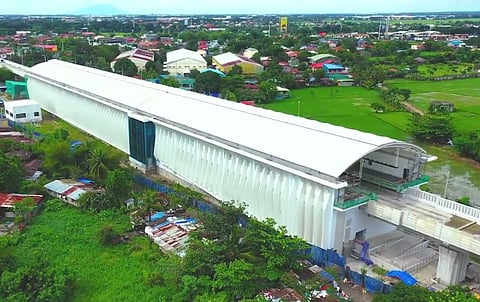Revealed: 'Shinkansen-inspired' Philippine rail project rollout date, challenges
Up to 60% reduction in commute times — from 3 hours by road to under 1 hour by rail

Manila: Significant progress has been made on tThe North-South Commuter Railway (NSCR) Project in the Philippines, currently under construction.
The NSCR project is at roughly 65% completion (Phase 1) for the Manila-Clark segment as of early 2025, though the Department of Transportation (DOTr) has reported varying completion figures for different segments.
Ambitious project
At $15.4 billion (P873.6 billion), the NSCR is the country’s most ambitious rail initiative yet aimed to reduce commute times and ease congestion in Metro Manila and surrounding provinces.
Construction has been delayed. The reasons cited: right-of-way (ROW) snags and site obstructions.
But progress continues steadily. Clearing and dismantling operations have accelerated to push the project forward.
For example, ROW issues in six key areas from Calumpit, Bulacan to Clark, Pampanga had been cleared, paving the way for faster completion, DOTr reported on October 9, 2025.
Here's the detailed status based on latest information in 2025:
Status and completion rate
Tutuban to Malolos segment: around 43-78% completion depending on source and date.
Malolos to Clark segment: around 33-50% completion as of mid-2024 to 2025.
Manila to Calamba segment: Completion is much lower, around 7-12% (this is the toughest segment due to ROW and challenges from informal settlers.
Recent updates from the DOTr indicate that civil works on Phase 1 are 65% complete as of October 2025, bolstered by the delivery of 108 new train cars from Japan’s JR East and Sumitomo.
Train fares?
The DOTr has pledged affordable fares for the NSCR, but exact fare matrices are not finalised publicly.
Based on current Philippine National Railways standards for commuter lines, fares could be distance-based and affordable, likely lower than other private transport modes.
Historical and current fares on related commuter lines range from single digit to a few dozen pesos depending on distance. No exact fares for NSCR are confirmed as it is still under development.
Coverage
The entire NSCR is approximately 147 kilometers long.
The railway spans several provinces: Metro Manila, Bulacan, Pampanga, and Laguna at a minimum.
The project features 35 stations and 3 depots.
28 Japanese companies, including powerhouses such as Mitsubishi, Hitachi, Tokyo Metro, Sumitomo, and Alstom Japan, have formally expressed interest in bidding for the NSCR operations and maintenance (O&M) contract.
The NSCR will operate under a public-private partnership (PPP) framework.
Winning concessionaire will assume full system management ahead of its staged rollout (i.e. train operations, signalling, passenger services and infrastructure upkeep for an initial 15-year term)
Financing: The project is partially financed through concessional loans: ₱488 billion from the Japan International Cooperation Agency (JICA) and ₱142 billion from the Asian Development Bank (ADB)
Japan’s involvement extends beyond funding, with Japanese firms leading civil works construction under separate contracts awarded to consortia including Shimizu and Obayashi.
Segments
Spanning 147 kilometers, the NSCR comprises three interconnected segments:
PNR Clark Phase 1: Tutuban to Malolos (38 km, elevated viaducts and stations)
PNR Clark Phase 2: Malolos to Clark International Airport (53 km, including a depot in Valenzuela)
PNR Calamba: Solis to Calamba (56 km, linking southern provinces)
NSCR Status (October 2025)
| Aspect | Details |
|---|---|
| Completion Rate | ~50% overall (higher on certain segments) |
| Length | Approximately 147 km |
| Provinces Covered | Metro Manila, Bulacan, Pampanga, Laguna |
| Stations and Depots | 35 stations, 3 depots |
| Opening Date | Partial operations as early as 2027; full line by 2028 |
| Train Fares | Affordable, expected to be distance-based; exact fares not yet finalised |
Congestion relief
The railway will accommodate up to 800,000 daily passengers — featuring modern Japanese "Shinkansen-inspired" tech, including automatic train control systems and earthquake-resistant designs.
Beyond congestion relief, the NSCR aligns with the Philippines’ “Build, Better, More” infrastructure agenda under President Ferdinand Marcos Jr.
Independent Studies by the ADB project a 60% reduction in north-south commute times — from over 3 hours by road to under 1 hour by rail — while cutting annual CO₂ emissions by an estimated 200,000 tons through modal shift from cars and buses.
The project also incorporates sustainability features, such as solar-powered stations and regenerative braking systems.
For seamless transfers, it will integrate with Metro Manila’s existing MRT-3, LRT-1, and upcoming subway lines
As the Philippines grapples with Metro Manila’s notorious traffic — ranked among the world’s worst by the 2025 TomTom Traffic Index — the NSCR represents a pivotal step toward modernising a railway system.
The modernisation promises economic boosts to regions like Bulacan, Pampanga, and Laguna through enhanced connectivity and job creation.
Sign up for the Daily Briefing
Get the latest news and updates straight to your inbox


